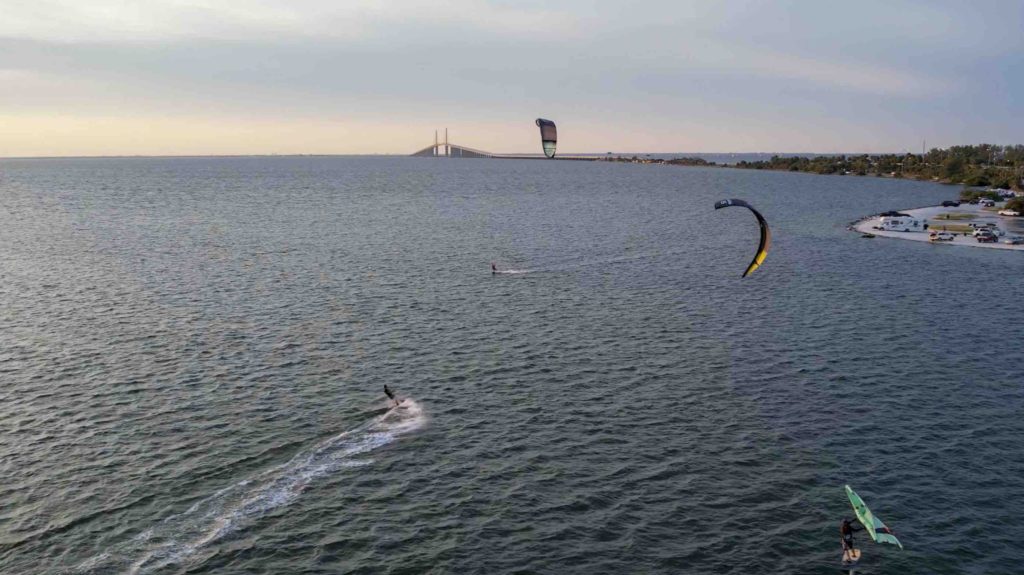Allgemein
Eigenständig Kiteboarden
Wann kann ich eigenständig Kiteboarden?
Viele Anfänger stellen sich die Frage: „Wann kann ich eigenständig Kiteboarden?“ Bevor du eigenständig loslegst, gibt es einige grundlegende Fähigkeiten, die du beherrschen solltest. Ebenso wichtig ist die richtige Einschätzung der Umgebung, um Verletzungen zu vermeiden. In unseren Kiteboarding-Kursen vermitteln wir dir sowohl die nötige Situationswahrnehmung als auch die Grundfertigkeiten, um ein sicherer und unabhängiger Kiteboarder zu werden.
Dieser Artikel ist in zwei Abschnitte unterteilt:
- Situationswahrnehmung: Wie du die richtige Umgebung für das Üben auswählst.
- Kritische Fähigkeiten: Welche Fähigkeiten du benötigst, um sicher eigenständig zu üben.
Situationswahrnehmung für Anfänger
Kiteboarden ist nicht zu jeder Zeit, an jedem Ort und bei jeder Bedingung möglich. Es gibt ideale Bedingungen, aber auch Szenarien, die gefährlich sein können. Hier sind die wichtigsten Punkte, die du beachten solltest:
Windstärke:
Ist der Wind stark genug, aber nicht zu stark? Für Anfänger empfehlen wir Windgeschwindigkeiten von 10–20 Knoten. Die passende Kite-Größe hängt von deinem Gewicht und der Windgeschwindigkeit ab. Nutze einen interaktiven Rechner, um die ideale Kite-Größe zu bestimmen.
Windrichtung:
Achte darauf, dass der Wind Richtung Strand weht. Bei einem Worst-Case-Szenario wird dich der Wind so zurück ans Ufer treiben. Die besten Bedingungen sind Onshore-, Cross-Onshore- oder Side-Shore-Winde.
Wassertiefe:
Ideal ist hüfttiefes Wasser. Tiefes Wasser erschwert das Üben erheblich und sollte erst betreten werden, wenn du die Grundlagen sicher beherrschst.
Allgemeine Wetterbedingungen:
Stelle sicher, dass keine Stürme oder schlechtes Wetter die Sicherheit gefährden könnten.
Situationswahrnehmung am Strand
Noch bevor du zum Strand fährst, solltest du die Wind- und Wetterbedingungen überprüfen. Vor Ort gibt es weitere Punkte, die du beachten solltest, um Verletzungen zu vermeiden. Wenn du dir unsicher bist, bitte einen erfahrenen Kiteboarder um Hilfe. Ein wichtiger Grundsatz lautet: „Im Zweifel, bleib an Land.“
Andere Kiteboarder beobachten:
Sind andere Kiteboarder am Strand? Wenn nicht, überlege, ob es sicher ist, alleine zu üben. Anfänger sollten nie ohne Hilfe oder andere Kiteboarder in der Nähe üben.
Starten und Landen:
Wähle einen sicheren Ort, um deinen Kite aufzubauen und zu starten. Beobachte andere Kiteboarder beim Starten und frage bei Unsicherheiten um Rat.
Gefahren auf dem Wasser:
Nutze Google Earth oder sprich mit lokalen Kiteboardern, um mögliche Gefahrenstellen im Wasser zu identifizieren. Positioniere dich immer in einer sicheren Umgebung und beobachte deine Umgebung während der gesamten Session.
Kritische Fähigkeiten für eigenständiges Kiteboarden
Eigenständig Kiteboarden erfordert zwei wesentliche Dinge: Upwind-Fahren und sicheres Kite-Handling. Hier sind die grundlegenden Fähigkeiten, die du beherrschen solltest:
Starten und Landen:
Es gibt zwei Hauptmethoden:
- Mit Hilfe einer anderen Person: Dies ist die häufigste und sicherste Methode.
- Drift-Start: Diese Technik eignet sich, wenn du alleine bist. Wähle immer die sicherste Option.
Kite-Kontrolle in Neutralzonen:
Du solltest den Kite sicher in den Neutralzonen fliegen können. Dies ist wichtig, um nach dem Start sicher vom Strand wegzulaufen.
Wasserstarts:
Da Abstürze unvermeidlich sind, ist es wichtig, zu wissen, wie man den Kite aus dem Wasser neu startet.
Sicherheitssysteme:
Wenn ein Neustart nicht funktioniert oder eine gefährliche Situation eintritt, musst du die Sicherheitsmechanismen deines Kites beherrschen. Moderne Systeme sind einfach zu bedienen und schnell wieder zusammenzubauen.
Upwind-Body-Dragging:
Diese Technik ist besonders in tiefem Wasser wichtig. Sie hilft dir, sicher in flaches Wasser zu gelangen und die Kontrolle über deine Umgebung zu behalten.
Fazit
Kiteboarding-Lektionen können teuer sein, aber sie sind eine lohnende Investition in deine Sicherheit und Fähigkeiten. Unser Fokus liegt darauf, sichere und unabhängige Kiteboarder auszubilden. Sobald du die notwendigen Fähigkeiten entwickelt hast, bieten wir auch kürzere betreute Sessions an, um dir den Übergang zur Eigenständigkeit zu erleichtern.
Für weitere Informationen zu unseren Kursen, fülle einfach das Formular auf unserer Website aus!

